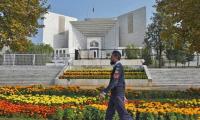KARACHI: Pakistan’s government debt decreased by Rs792 billion or 1.0 per cent, month-on-month in September, underscoring the government’s reduced financing needs resulting from the budget surplus, record-high central bank profits, and prudent expense management.
Data from the State Bank of Pakistan, released on Monday, showed that the federal government’s total debt stock fell to Rs69.57 trillion by the end of September 2024, down from Rs70.362 trillion at the end of August 2024.
However, the debt increased by Rs656 billion in the first quarter of the current fiscal year. As of June 30, 2024, the debt stood at Rs68.914 trillion.“As of September 2024, Pakistan’s debt-to-GDP ratio has dropped to 65.7 per cent, marking its lowest level since June 2018. The domestic debt-to-GDP ratio is at 43.1 per cent, while the external debt-to-GDP ratio stands at 22.7 per cent,” said Arif Habib Limited.
The latest debt figures were released as the International Monetary Fund (IMF) team is set to start discussions with Pakistani authorities to evaluate the country’s progress on the $7 billion loan programme. The main agenda of the IMF team is to assess Pakistan’s external financing gap and the measures being taken to address the shortfall in tax collection.According to data from the SBP, the government’s domestic debt rose to Rs47.536 trillion in the first quarter of FY25, an increase from Rs47.16 trillion at the end of the last fiscal year. However, on a month-on-month basis, the domestic debt declined. It recorded at Rs48.339 trillion at the end of August. Additionally, the government’s external debt increased to Rs22.034 trillion during the July-September FY25 period, compared to Rs21.754 trillion at the end of June. At the end of August 2024, the external debt stood at Rs22.023 trillion.
“Government debt has increased at its slowest pace in the first quarter since the first quarter of the fiscal year 2022. This deceleration in debt growth is attributed to the government’s first fiscal surplus in 20 years, recorded in the first quarter of this fiscal year,” said Awais Ashraf, director research at AKD Securities Limited. “The government reported a record primary surplus of Rs3 trillion and a fiscal surplus of Rs1.7 trillion for the first quarter,” Ashraf said.
“This positive outcome was driven by a historic Rs2.5 trillion dividends received from the State Bank of Pakistan and a significant 26 per cent increase in tax revenue collected by the Federal Board of Revenue (FBR) along with prudent management on the expenses front,” he added.
Saad Hanif, head of research at Ismail Iqbal Securities, said the central government debt rose from Rs62.3 trillion in September 2023 to Rs69.6 trillion in September 2024, with a focus on long-term debt.
“While domestic borrowing increased, the government favoured long-term debt, actively buying back Treasury bills and extending short-term debt into longer maturities,” Hanif said.“External debt remained stable with minor increases, and a slightly stronger Pakistani rupee softened its impact in rupee terms. This shift toward long-term debt could provide more stability and reduce refinancing risks, although overall debt levels continue to rise.”
According to the SBP’s data, Pakistan’s debt and liabilities increased to Rs85.836 trillion in the July-September FY25 period. This is up from Rs78.419 trillion during the same period last year.
In terms of dollars, the country’s total external debt and liabilities rose to $133.4 billion for the July-September FY25, compared with $131 billion at the end of June and $129.76 billion at the end of September 2023. The public external debt amounted to $100.619 billion as of September 30, 2024.
The SBP told analysts following the monetary policy meeting last week that the overall debt stock has declined, and debt composition has improved. In addition, the maturity profile of these debts has also improved due to the increase in the share of multilateral debts. The domestic outstanding debt profile has also improved as the share of short-term treasury bills has declined to 21 per cent in four months of FY25, compared with 24 percent at the end of FY24. The authorities expect this share to go below 20 per cent by the end of FY25.
According to the SBP, the reduction in interest rates and the timely use of surplus funds for debt profiling are expected to significantly lower the government’s debt servicing costs in fiscal year 2025. The government’s total interest expense for FY25 is now estimated to be Rs8.5 trillion, compared with Rs9.8 trillion projected in the budget for the current fiscal year. This reduction results in total savings of Rs1.3 trillion, which is approximately 1.0 per cent of gross domestic product. These savings will help in controlling the fiscal deficit for FY25. The SBP believes the gross financing requirements are expected to be met. Out of a total of $26.1 billion in external repayments for FY25, the country has to repay $6.3 billion in the remaining eight months of the current fiscal year.
This image uploaded on January 4, 2017, shows a Bank Alfalah branch. — Facebook@SundarInteriors&ArchitectsKARACHI:...
This image shows a general view of solar panels installed at a photovoltaic park in Cestas, France on December 1,...
Jazz headquarters are seen in this file photo. — X@Jazz/fileKARACHI: Jazz, together with JazzCash, Mobilink...
Gold bars are seen in this undated file photo. — AFP/FileKARACHI: Gold prices decreased by Rs5,500 per tola on...
Pakistan and China flags can be seen in this image. — Xinhua/FileLAHORE: The department of commerce of China’s...
A man rides a motorcycle along the solar panels in Gujarat Solar Park also called Charanka Solar Park at Patan...







